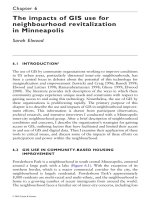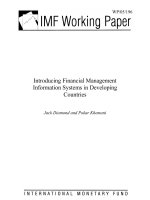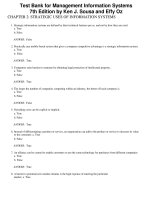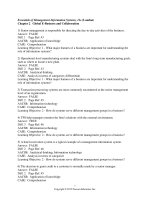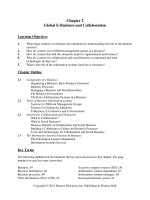Lecture Management information systems - Chater 6: Telecommunications and networks
Bạn đang xem bản rút gọn của tài liệu. Xem và tải ngay bản đầy đủ của tài liệu tại đây (2.82 MB, 74 trang )
Copyright © 2006, The McGrawHill Companies, Inc. All rights reserved.
6-1
Chapter
6
Telecommunications
And Networks
Copyright © 2006, The McGrawHill Companies, Inc. All rights reserved.
6-2
Learning Objectives
1. Identify several major developments and
trends in the industries, technologies
and business applications of
telecommunications and Internet
technologies.
2. Provide examples of the business value
of Internet, intranet, and extranet
applications.
Copyright © 2006, The McGrawHill Companies, Inc. All rights reserved.
6-3
Learning Objectives
3. Identify the basic components, functions,
and types of telecommunications
networks used in business.
4. Explain the functions of major types of
telecommunications network hardware,
software, media, and services.
Copyright © 2006, The McGrawHill Companies, Inc. All rights reserved.
6-4
Why Study Networking?
• When computers are networked, two
industries – computing and
communications – converge, and the
result is vastly more than the sum of the
parts.
• Suddenly, computing applications
become available for business-tobusiness coordination and commerce,
and for small as well as large
organizations.
Copyright © 2006, The McGrawHill Companies, Inc. All rights reserved.
6-5
Case #1: Wireless Business Applications
Business Value of Wireless:
• Time is money. Pocket PCs help reduce
travel time at Celanese Chemicals related
to plant equipment diagnosis.
• Fidelity Investments attracts customers by
offering services via wireless devices.
• GM uses wireless devices to improve
forklift operator productivity and cut costs.
Copyright © 2006, The McGrawHill Companies, Inc. All rights reserved.
6-6
Case #1: Wireless Business Applications
1. What is the business value of wireless
technologies in the chemicals and automotive
manufacturing industries? What other
manufacturing applications might benefit from
wireless technologies? Why?
2. What are some of the business benefits of
wireless technologies in finance and
investments? What other applications would
you recommend? Why? Check the website of
Fidelity.com to help you answer.
Copyright © 2006, The McGrawHill Companies, Inc. All rights reserved.
6-7
Case #1: Wireless Business Applications
3. What are some of the business benefits and
challenges of using wireless technologies in
retailing? What are some other applications
that might be beneficial to consumers, as well
as retailers? Why?
4. What are some of the major challenges
limiting the widespread use of wireless
technologies in many business applications?
What can be done to meet such challenges?
Copyright © 2006, The McGrawHill Companies, Inc. All rights reserved.
6-8
Telecommunications
Definition:
• The exchange of information in any form
(voice, data, text, images, audio, video)
over networks
Copyright © 2006, The McGrawHill Companies, Inc. All rights reserved.
6-9
Trends in Telecommunications
Copyright © 2006, The McGrawHill Companies, Inc. All rights reserved.
6 - 10
Open Systems
Definition:
• Information systems that use common
standards for hardware, software,
applications, and networking
Copyright © 2006, The McGrawHill Companies, Inc. All rights reserved.
6 - 11
Connectivity
Definition:
• The ability of networked computers and
other devices to easily access and
communicate with each other and share
information
Copyright © 2006, The McGrawHill Companies, Inc. All rights reserved.
6 - 12
Interoperability
Definition:
• The ability of an open system to enable
the many different applications of end
users to be accomplished using the
different varieties of computer systems,
software packages, and databases
provided by a variety of interconnected
networks
Copyright © 2006, The McGrawHill Companies, Inc. All rights reserved.
6 - 13
Digital Network Technologies
Definition:
• Digital transmission technologies that transmit
information in the form of discrete pulses
Benefits:
• Higher transmission speeds
• Movement of larger amounts of information
• Greater economy
• Lower error rates
Copyright © 2006, The McGrawHill Companies, Inc. All rights reserved.
6 - 14
Business Value of Telecommunications
Copyright © 2006, The McGrawHill Companies, Inc. All rights reserved.
6 - 15
Internet
Definition:
• A network made up of millions of smaller
private networks each with the ability to
operate independent of, or in harmony
with, all the other millions of networks
connected to the Internet
Copyright © 2006, The McGrawHill Companies, Inc. All rights reserved.
6 - 16
Internet
Copyright © 2006, The McGrawHill Companies, Inc. All rights reserved.
6 - 17
Internet Applications
Copyright © 2006, The McGrawHill Companies, Inc. All rights reserved.
6 - 18
Business Use of the Internet
Copyright © 2006, The McGrawHill Companies, Inc. All rights reserved.
6 - 19
Business Value of the Internet
Copyright © 2006, The McGrawHill Companies, Inc. All rights reserved.
6 - 20
Intranet
Definition:
A network inside an organization that
uses Internet technologies to provide an
Internet-like environment within the
enterprise for information sharing,
communications, collaboration, and the
support of business processes
Copyright © 2006, The McGrawHill Companies, Inc. All rights reserved.
6 - 21
Business Value of Intranets
• Communications and Collaboration – includes
email, voicemail, paging, faxes, and groupware
• Web Publishing – easy, attractive and low-cost
way of publishing and accessing multimedia
business information
• Business Operations and Management –
platform for developing and deploying critical
business applications to support business
operations and managerial decision making
across the inter-networked enterprise
Copyright © 2006, The McGrawHill Companies, Inc. All rights reserved.
6 - 22
Business Value of Intranets
Copyright © 2006, The McGrawHill Companies, Inc. All rights reserved.
6 - 23
Extranet
Definition:
• Network links that use Internet
technologies to interconnect the intranet
of a business with the intranets of its
customers, suppliers, or other business
partners
Copyright © 2006, The McGrawHill Companies, Inc. All rights reserved.
6 - 24
Business Value of Extranets
Copyright © 2006, The McGrawHill Companies, Inc. All rights reserved.
6 - 25
